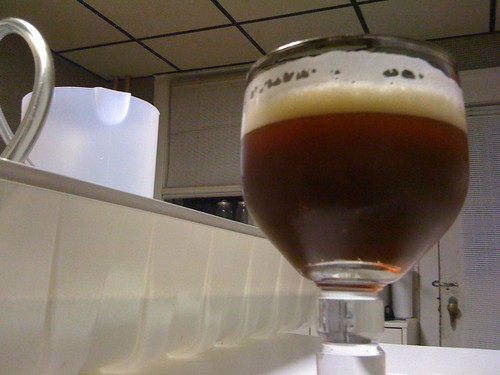Inspired by Kevin’s post on his Belgian session brew, I thought I should post one of my own. A few weeks back, I brewed up a beer I thought would be an American Rye. The ingredients of interest were rye (obviously), a Columbus-like hop called Zeus (the Z in the CTZ family) and Fermentis’ Safbrew T-58 yeast. I expected all of these ingredients to blend well, as they each have a peppery/spicy flavor. I’ve read that the T-58 is a Belgian strain, with an estery profile best suited for saisons or Belgian specialty ales. I used it in an IPAbbey clone I did over the summer, which fermented in the mid to high 70s. The beer was fantastic, but I felt it had almost no Belgian character. At the time, I wrote the yeast off as being too neutral for Belgian beers. In retrospect, I may have just missed the yeast contribution in all of the hops (3oz at the end of the boil and another 3oz for dry hopping). I had an extra packet of T-58 in the fridge and a bit of the 2008 Zeus crop in the freezer that needed to be used up. So, I decided to test the T-58 yeast once more, using it as an American wheat/rye yeast. My theory was if the peppery flavor came through at all, it would complement the rye and Zeus hops nicely. I also threw in a touch of crystal 120L malt. I’ve not really noticed myself, but I’ve read that 120L crystal gives, in addition to a dark fruit flavor, a slight smoky, pipe tobacco aroma to beers. Seemed like a nice touch. Lastly, I added a bit of sugar to dry it out and get the hops come through more.
The day I brewed this, it was a very last minute decision. I didn’t have much time – basically, I did it while my wife was out shopping! I did this as an extract batch with specialty grains and cut the boil back to 20 minutes. Since extract is already converted and boiled by the manufacturer, it really only needs to be boiled to sanitize it. The drawback to short boils is a loss of hop utilization, but since I was shooting for relatively low IBUs and I was trying to use up old hops with high alpha levels, this really wasn’t an issue.
I should also point out that I do not know if the rye in this recipe was just rye grain or Wyeremann’s rye malt. The label at the homebrew store just said “rye” and when I asked about it, the guy at the store had no idea what it was. I guess you could use either – just expect higher gravity and less haze with the malted stuff. For what it’s worth, in the recipe below I treated the rye as if it were malted, steeping it at a temp it could convert at for 20 minutes, then “sparging.”
I think I set a record with this batch: steep, boil, cool and cleanup in something like 2 hours! Not bad. Anyway, here is the recipe:
Grains:
3.3 lbs Breiss wheat malt extract
3 lbs Rye
1.5 lb Briess light DME
4 oz organic cane sugar
2 oz Crystal 120L
Hops:
.65 oz Zeus hops (16.4% AA) – 20 minutes
.5 oz Zeus (16.4% AA) – 10 minutes
.5 oz Zeus (16.4% AA) – 0 minutes
Yeast:
Fermentis SafBrew T-58
OG 1.049, FG 1.012, IBU 28 SRM 6.4 ABV~5%
Bring 5.5 gallons of water up to 154. Steep the rye and crystal malt for 20 minutes. Bring up to 170, then gently pour water from your kettle over the steeping grains a few times to wash off any sugars. DO NOT SQUEEZE YOUR SACK of grains. I believe it’s been said before on this blog, squeezing your sack is never a good idea. Remove the grain and bring to boil. Add the extracts and sugar and boil for 20 minutes. Add the hops at times above. Chill to 65 and ferment at 68 for about 2 weeks.

Though this came out much different than I expected, I was pleasantly surprised. The yeast really gave the beer a noticeable Belgian character, much more so than the last time I used it. Perhaps the colder temperatures brought out more flavor, though that seems contradictory to typical yeast behavior (especially Belgian yeast). Anyway, it came out tasting like a really refreshing “table saison” – a farmhouse ale with lower alcohol content than the traditional style. Very balanced, yet evident spicy hop flavor. The estery yeast and black pepper flavors from the rye complemented each other very nicely, giving the beer a good amount of complexity. At the same time, the wheat gave it a refreshingly light finish. The crystal malt added a nice golden-orange hue and there was some light haze in the body, which cleared significantly as I got closer the bottom of the keg. Along with the low ABV, the balance in the body from the mix of barley, wheat and rye made this really easy to drink.
I will definitely be brewing this one again when the weather gets warmer. This will make for a great spring/summer session beer.









